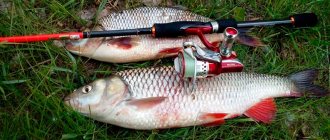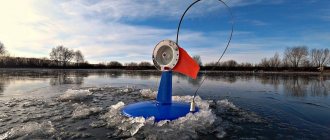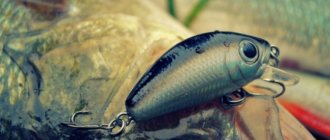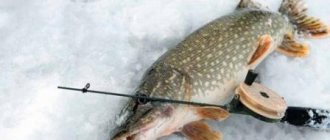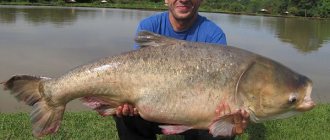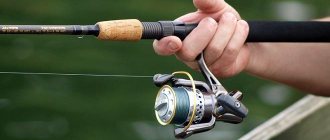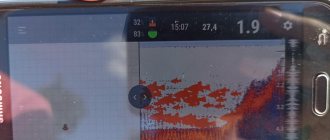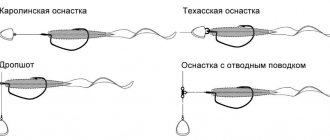Spinning perch fishing is quite an interesting and exciting activity. Of course, you come across perch more often than pike or pike perch, but this only adds to the excitement.
When catching this type of fish, it is important to know about the features of preparing gear and playing techniques. In the article we’ll talk about an equally important aspect – choosing a spinning rod for catching perch.
Basic spinning parameters:
- Test
- Length
- Build
- Material
- Design
A test is a value that characterizes the permissible weight of baits used with a specific fishing rod. Action is the specific shape that a rod takes when loaded. Characterizes the level of sensitivity of the rod and its flexibility, potential casting range.
Design features are also important, namely the convenience of the handle and the material of manufacture, the location and features of the access rings. Since perch is usually caught using small baits, it is advisable to take a minimal spinning test.
Selecting a spinning rod
Rod
The size of the perch itself, its food items, and habitat suggest the use of light and ultra-light class gear:
- A lightweight carbon fiber spinning rod with a test range of 2-10 g or 3-14 g and a length of 2.4-2.7 m is the most universal tackle for catching perch. Shorter rods are usually only suitable for fishing from a boat, while longer ones most often do not have the best action, with the exception of expensive professional models.
- Ultralight class spinning rods allow you to catch almost any fish, but are usually used when catching low-active perch with minimum-sized baits or for “sport” fishing in urban reservoirs for perch of the appropriate “sports” size.
The spinning rod action for perch should be fast or medium-fast. It allows you to fish with any type of bait, and successful fishing can be ensured by correctly setting the reel clutch. A parabolic system, which is more suitable for fishing for perch, will not allow for high-quality jigging or twitching.
Rod for spinning perch fishing
Coil
To catch perch, in the vast majority of cases, spinning reels are used. The choice of coil must ensure that the following conditions are met:
- balance of all gear - usually medium-sized reels are used;
- even, high-quality laying of the fishing line - this characteristic is very important, since uneven wiring is often used, and the tension of the fishing line is constantly changing;
- Precise adjustment of the reel's friction brake is necessary, despite the small size of the perch, since it has rather weak lips and excessive force when fishing can lead to the fish disappearing.
fishing line
Depending on the fishing method, monofilament and braided lines are used. Typically the line is used with spinners and similar lures. When fishing with jig baits, braid is used. The use of wobblers and oscillating spoons implies the choice of fishing line based on the personal preferences of the angler.
An example of an inexpensive but high-quality reel
Leash
The use of metal leashes in perch fishing raises a lot of controversy. The perch cannot bite through the fishing line, and the presence of a metal leader usually reduces the number of bites. On the other hand, when fishing for perch, there are frequent bites from pike, which is almost impossible to fish without a leash. As a solution to this problem, it is possible to use fluorocarbon leaders or leaders made of soft metal leader material of minimal thickness.
In places where pike are not found or where pike are unlikely to bite, fishing with a spinning rod does not require the use of a metal leash.
Build
Rod action is divided into slow, medium and fast. Slow ones are characterized by bending of the whip under load along the entire length, while fast ones are characterized by bending only at the tip.
Rods with a medium action bend to the middle of the whip. The sensitivity when playing and hooking fish depends on the action, and it also affects the casting distance of the selected bait.
Rods with slow and medium action will allow the fisherman to make long casts, have good flexibility and sensitivity when retrieving, and are able to absorb the jerks of the fish. For these reasons, such rods are excellent for catching perch.
Spinning rod classes
All spinning rods are divided into classes:
- ultralight (light), its test range is from 0.2 to 15 g;
- average from 15 to 30 g;
- heavier class from 30 g and above.
What is a test?
The spinning test is indicated on each rod or spinning rod. It looks like numbers, for example test 0.3 - 12 g. This means that the tackle is intended for a wobbler, silicone or spinner of the specified weight.
What is a system?
Action is the flexibility of a rod. For perch fishing, it is better to choose the most flexible spinning rod. The softer it is, the more sensitive the bite will be. They are divided into 4 systems:
- Extra fast. The rod is very rigid, only the tip itself bends.
- Fast. The rod is rigid, weakly bends and very sensitive, but it is not capable of long casting, but it has high casting accuracy.
- Medium tuning bends to the middle.
- Small action (slow) makes the longest cast, but has low sensitivity and is not very accurate.
The choice depends on the type of reservoir where perch fishing will take place.
What to look for when purchasing
When choosing a spinning rod, you should not save money. It’s better to buy a branded item once that will last for years than to change equipment or buy a new fishing rod every fishing trip.
Points worth paying attention to:
- It should not crunch when bent; this indicates microcracks.
- A light spinning rod for perch would be an excellent option.
- All rings must be securely glued.
- The reel mount must be metal and not soft.
- The handle and holder should be very comfortable and soft in your hands. After all, sometimes you have to walk with a spinning rod for more than one hour.
- The threads at the end of the handle on the lid and on the reel should not be torn off; this is definitely worth checking.
- There should be no scratches or nicks on the spinning rod itself.
You need to pay attention to all suspicious points and ask questions to the seller.
How to choose a spinning rod for perch for beginners
Lures for catching perch using a spinning rod
- wobblers
- spinners
- oscillating spoon
- silicone baits
Selecting a spinning rod (video)
Also read our interesting articles on the topic of spinning:
- The best budget spinning rods
- Budget reels for spinning rods
- Budget reels for ultralight spinning rods
- Spinning equipment
- What materials are fishing rods made of?
- About offset hooks
- Floating silicone baits
- DIY silicone baits at home
- A selection of articles about spinning gear
Author of the article: Vitaly Leonidovich Ivanov, 2021.
Perch tackle
For autumn fishing, all perch gear used when catching this predator during the period of open water is applicable. List and equipment of gear used for perch fishing:
Spinning. Fans of active fishing prefer spinning rods. Perch on a spinning rod is caught from the shore and boat
For comfortable fishing, it is important to choose the right gear elements and equip the spinning rod.
When choosing a spinning rod for perch, you need to pay attention to its length, test and action. The length of the rod should ensure convenient casting of the bait to the perch in specific fishing conditions
The optimal option is 2.4 m. A spinning rod of this length is excellent for fishing from the shore and boat. Test within 5 - 15 grams. For timely hooking and retrieving, a rod model with a medium action is suitable.
Inertialess reels are very popular. But you shouldn’t ignore high-quality inertial coils. The type of reel is selected at the request of the spinner.
To catch perch, a spinning rod is equipped with a fishing line or cord. When choosing a fishing line or cord for a spinning rod, you need to focus on the load capacity. The equipment for perch must withstand a tensile load of at least 5 kg.
If there is a pike in the pond, then it is better to play it safe and install a metalized leash. The toothy predator is often tempted by baits designed for catching perch;
Float rod. A Bologna fishing rod with a rod length from 2.7 m to 6 m is excellent for catching perch. The length of the rod depends on the fishing conditions. Supporters of fly rods or match rods do not change their habits when specifically fishing for perch.
Fishing for perch with a float rod is carried out with traditional bait or used as live bait. Single hooks of sizes 3.0 – 4.0 according to domestic numbering are applicable. Doubles or tees are installed on live bait equipment. With their help, the bait is correctly mounted, ensuring its mobility until the predator bites. The “freedom” of movement of live bait is limited by a leash 30-50 cm long.
Retention of live bait in the bottom layer of water is ensured by tying a sinker, under the weight of which the float is loaded;
- Mugs for perch. On large rivers, large lakes and reservoirs, fishing for perch with mugs is used. The fishing is the same as fishing for pike with mugs;
- Summer girders. Summer girders are successfully used for catching perch from the shore. These live bait gear are used when dumps or cliffs are found in the coastal zone.
Read: DIY winter fishing tent
Perch spinning rod for jig fishing
More than two decades ago, at the DAM representative office, I received one model that was unusual for those times for testing. I had to try it out and give recommendations for use.
Kit for “heavy jigs” based on a spinning rod up to 4 grams
The problem was that the test for that model was up to 5 g, and braided lines that were more or less compatible with a spinning rod of such an ultra-light class simply did not exist in those years. But somehow I got out of the situation. And with that spinning rod I caught, for example, bleak with “triple zeros”. You may even remember my article on this topic.
But I found another use for that DAM model. I don’t remember exactly how I came to this, but I managed to catch perches with it on the “Devil”. Yes, the same one that is so familiar to many winter fishermen. Only I fished, of course, not vertically, but by casting. Then it was hardly possible to imagine that something like this, only with much more appropriate elements of swearing. 77 parts, will gain popularity many years later.
This is usually called “mormyshing”, or even, excuse me, “mormoding”. When they catch perch (and not only) with a spinning rod, it is with a jig. Well, or on a jig head of the appropriate size and weight. And their weight indicators usually fall within the range of 0.2 - 0.6 g. Together with the bait made of “edible rubber”, the total weight of the structure is 0.5 - 1.5 g.
Rarely more. Cords are used more often - #0.3, but also #0.2. These are such tiny threads that “normal” spinners would probably never deal with. But the mormyshers are used to it. This is their fishing ideology. Class - super-ultralight. Accordingly, the top test for spinning rods (we’re talking about them more today) is 2 - 3 grams. And if it’s 4 grams, then in this context it’s already “heavy”. Models with such characteristics are taken more often from trout, less often from marine rockfish series of spinning rods.
This is where one contradiction lies. Aryan spinning rods are most often regular in formation. Sometimes even regularly and slowly. And jig fishing involves not only the use of the jig itself, but also the corresponding feeding technique. That is, animation of the rod with twitching, shaking, etc. And ideally, for such types of animation it should be somewhat faster in structure than typical trout models.
But “fast” spinning rods are noticeably worse at throwing small loads close to the lower limit of the test. In mormyshing this is sometimes critical. Here everyone decides for himself what is more important to him. And some jig fishers carry two or even three already assembled spinning rods with different characteristics. Everything is serious with them.
Rating of spinning rods for perch
There are several main positions in the ranking.
- The Maximus Legend-X 18UL 1.8m is an all-rounder that combines power and sensitivity with a fast action. Allows you to work wobblers, jig baits and small spoons as efficiently as possible.
- Kosadaka Lighting 210UL – middle class and good sensitivity. Excellent for catching medium sized perch.
- Volzhanka Lux 2-7 – medium range spinning rod. It has universal sensitivity and is preferable for working with small spoons.

